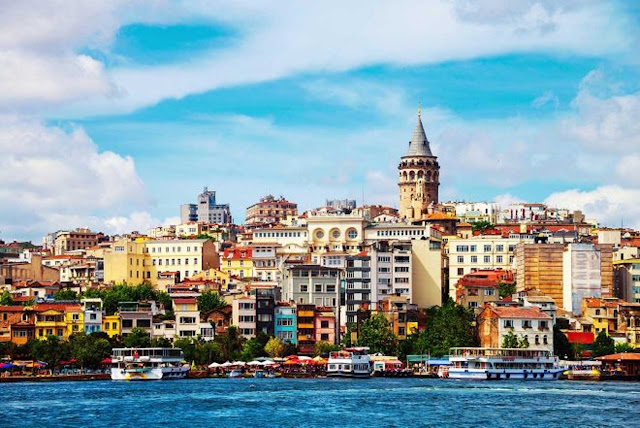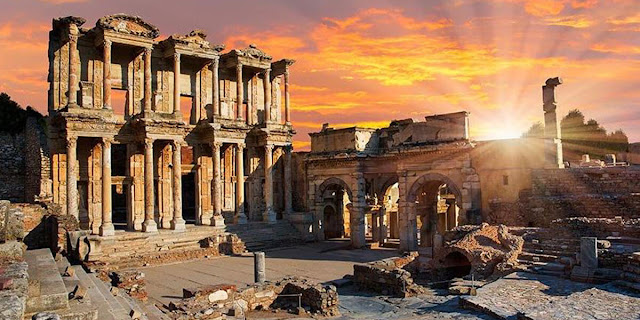🕒 2 Hours (approx.) 💬 Offered in: English
Istanbul > Istanbul Tours › Strolling Through Istanbul's Artistic Streets

🕑 3 Hours (approx.) 💬 Offered in: English

🕔 5 Hours (approx.) 💬 Offered in: English
Last spring, I guided a small group through Istanbul's quiet morning streets at dawn. As we rounded the corner near Süleymaniye Mosque, one of my guests gasped. The rising sun painted the ancient dome in gold, while thousands of tulips swayed in the courtyard's gentle breeze. "I never knew Turkey had tulips." she whispered. I smiled, sharing how these flowers originated here before making their way to the Netherlands.
These moments - watching visitors discover Türkiye's unexpected treasures - remind me why I love being a guide in this remarkable country.
You can book my old city Istanbul walking tour here:
As someone who's led countless travellers through Türkiye's diverse landscapes for over a decade, I'm often asked:
"When is the best time to visit Turkey?"
The answer unfolds like a Turkish coffee fortune reading - it depends on what stories you want your journey to tell.
From the sun-warmed stones of ancient cities to the mist-wrapped mountains of the Black Sea, each season writes its own unique tale.
Let me share the secrets I've gathered from years of showing travellers the hidden rhythms of Turkish seasons.
Spring stands out as the prime season for exploring Türkiye. Temperatures hover between 15-22°C (59-72°F), creating perfect conditions for wandering through ancient ruins and cityscapes. Istanbul transforms during April's Tulip Festival, with millions of flowers painting the city in vibrant colours.
Local Insight: Visit Topkapi Palace gardens early morning in April. The morning light creates stunning photo opportunities with tulips framing the historic architecture, and you'll avoid the midday crowds.

Money-Saving Tip: While coastal areas command premium prices, Cappadocia offers surprising summer deals. Luxury cave hotels often reduce rates by 20%, making it an ideal time for budget-conscious travellers seeking unique experiences.
Check here for the best hotel deals for Cappadocia
Booking.comFall brings Türkiye's most balanced weather, with comfortable temperatures and fewer tourists. Istanbul reveals its authentic character during these months - local neighbourhoods buzz with activity, and rooftop restaurants offer spectacular views without summer crowds.
Local Secret: October in Cappadocia coincides with the grape harvest. Join small-group vineyard tours to taste local wines and learn about the region's 4,000-year-old wine-making tradition.
Winter presents Türkiye's most affordable travel season. Istanbul's luxury hotels slash prices by up to 40%, while ancient sites offer peaceful exploration without crowds. The snow-covered landscapes of Eastern Türkiye create spectacular photo opportunities.
Insider Tip: Book Istanbul's historic hammams for early morning sessions in winter. The centuries-old bathing ritual becomes even more magical when steam rises against cold winter air.
History Buffs: March-May or September-November
Beach Lovers: June-September
Budget Travellers: November-March
Photography Enthusiasts: April-May
Practical Planning Tips:
Ready to experience Türkiye's seasonal magic? Check out my curated small-group tours [link] or contact me for personalised travel planning [link].
Have you experienced Türkiye in different seasons? Share your favourite time to visit in the comments below!
However, it’s important to be aware that Turkey, for all its liberal aspects and its cosmopolitan cities, is an Islamic country, and one that is moving closer to traditional Middle Eastern values on a daily basis. This is a similar situation to gay rights in Indonesia, and Malaysia, and shows no signs of letting up. Unfortunately, this is having a very real and visible effect on LGBT rights in Turkey that gay travellers to the area should take into account when planning a trip.
It is such a beautiful country that the LGBT community should feel excited to visit it, but it’s vital to keep the religious and political situation in mind. Since the attempted coup in 2016, religiously conservative President Erdogan has worked hard to consolidate his power and silence dissent, and the situation is turbulent. This guide aims to provide a summary of the situation in Turkey to help LGBT travellers prepare for a trip there.
Unlike many Muslim countries, Turkey does not technically outlaw homosexuality. In fact, same-sex sexual activity was legalised in the Ottoman Empire in 1858 and homosexuality has been legal since 1923 when modern Turkey was founded. As with heterosexual sex, the age of consent is 18.
There, however, some quite vague bans in the criminal code on “ offences against public morality” which can be, and have been, interpreted to be used against the LGBT community. Additionally, homosexuals are banned from military service.

In July 2016 there was a failed attempt at a coup and since then Erdogan has spearheaded a nationwide crackdown on freedom of expression in order to maintain his power. This overall move against opposing opinions has had a huge impact on LGBT organizations and the wider community; evidence of this was seen clearly in the police violence at the Pride march in Istanbul in July 2018, which has been banned for the fourth year running. Using the security situation as an excuse, Ankara has now prohibited all LGBT activity.
At the moment LGBT people in Turkey are not protected either in the public sphere or in employment through anti-discrimination laws. This is despite the efforts of some opposition parties who have attempted to introduce bills that would allow gay and transgender people legal protection.
Although homosexuality is technically legal, life as a member of the LGBT community in Turkey can be extremely challenging. A report published by Human Rights Watch in 2008 showed how gay and transgender communities face a threat of violence and discrimination on a daily basis. It further highlighted the lack of response from the authorities and the police.
Regretfully, as religion has an increasing influence on politics and society, this situation is only getting worse. No person in authority wishes to speak out in support of the gay community.
The social situation for members of the gay community is better in cosmopolitan Istanbul than in rural areas, where honour killings still occur; but whether or not people feel comfortable coming out to their family and friends completely depends on their own context and would still mean a number of risks.
At the time of writing, it’s difficult to see what will happen to LGBT rights in Turkey. The shift towards conservatism in Turkey as a whole does not bode well, but given the reliance on tourism in many areas and the long-established liberalism of Istanbul, there might be enough open-minded individuals to hold back the wave of fundamentalism.
Although legally speaking trans rights are further forward than in other countries in the area, as transsexuals have been permitted to change their legal gender since 1988, there is still a lot of discrimination against trans people and many incidences of violence.
This is perhaps surprising in a country where transgender women ran for parliamentary office in 2015 and when one of Turkey’s most popular singers is transsexual, but this was also a country that had colour-coded identity cards, so gender roles were very traditional awhile ago.
As in many conservative countries, there is a certain element of ‘don’t ask, don’t tell’ in place, particularly a country that welcomes on tourism the way Turkey does. Travellers going to Turkey should feel encouraged to enjoy their time and feel confident in receiving a warm welcome. In addition, technically they have full legal protection.
There are nowhere near the levels of oppression that are experienced in many countries in the nearby Middle East, but at the same time, travel here is not going to be as open as travel in Bangkok or Berlin, for example.
Public displays of affection between heterosexual couples are frowned upon as well, so any travellers would be advised to be discrete, not just gay travellers. Interestingly, a lot of Turkish men hold hands or walk with their arms around each other’s’ shoulders; this is actually a common expression of friendship.
Turkey is a huge and varied country and there are multiple areas to explore. Generally speaking, gay travellers should feel comfortable going all over the country and not let any fear limit their adventures.
For a more liberal scene, the only cities that would be recommended are Izmir and Istanbul. The main gay district there is around Taksim and Beyoglu is also an extremely forward-thinking area. Even Ankara and Izmir, Turkey’s capital and most Western-leaning city respectively, don’t have anything that comes close to being described as a ‘gay scene’, so while they’re interesting places to visit, gay travellers shouldn’t expect a party.
As in every country, the more rural the area, the more conservative the views held. Gay travellers in the countryside should take extra care to be discreet. However, the resorts along the Mediterranean and Aegean coasts have plenty of bars, clubs, and restaurants that will welcome anyone. Bodrum, for example, is famous for its tolerance.
Gay couples or single gay travellers hoping to meet people should not experience any issues if they are booked in international, upscale hotels. Luxury hotels will not be hugely pricey compared to Europe or North America (although prices are rising) so if travellers are would like a completely stress-free trip this will be the best option.
One thing it is important to be aware of in Turkey is that all visitors to hotels have to be recorded in a police-controlled database, so if you want to bring a date back at the very least you’re going to face some awkwardness, and at the very most it will be outright forbidden without checking him/her in.
Serviced apartments or Airbnb are also accommodation options that will save gay travellers having to run the gauntlet of a 24-hour reception. However, the doormen working in apartment blocks might notice more than people are aware of and that information could be passed on, so even these options should be located in more liberal areas.
Travellers might be tempted by the extremely low costs of some hostels but the lower the costs, the more likely it is that police will raid the accommodation.

Turkey boasts an extraordinary wealth of history, natural wonders, and culinary discovery. Travellers can visit the ancient port city of Ephesus, let Cappadocia take their breath away or hike the Lycian way. They can chill on a beach or pack a day full of the sights in Istanbul.
Aside from these glories, gay travellers will have to go to specific areas to find anything like a gay scene. As outlined above, Istanbul or the beach resorts are the best places for gay travellers to go to if they’re looking to party all night. Turkish people love music and dancing, so really it’s no surprise that a night out in Istanbul or Bodrum is going to be pretty fabulous. As always, people should be careful when leaving clubs or bars.

As discussed, big events like Pride are now extremely rare and often take the form of protests rather than celebrations tourists could join.
There is also a range of hamams, but they are frequented by everyone because they are such a traditional Turkish experience, so gay travellers should not assume they are specifically gay focused. Given the current situation, it would probably be better just to enjoy the baths as cultural experiences unless certain otherwise.
Getting to know people is one of the best things about traveling and that’s particularly important in a place like Turkey, where the gay scene is not always ‘in your face’.
If you are staying in Istanbul or a seaside resort like Antalya, starting a night out in a known gay-friendly bar is a good way to get chatting to locals and then plan your night from there.
In the face of adversity, there’s a strong feeling of family in the Turkish gay community and it’s good to get to know more about it. Hornet and Grindr (for men) and Wapa and Okcupid (for women) are the most prevalent gay social networking apps in Turkey. Tinder is also commonly used for all genders.

Compared to almost everywhere else in the Middle East (Tel Aviv aside), Turkey is (still) one of the more liberal countries gay travellers can visit. There will definitely be opportunities for partying and fun, as well as seeing the glories the country has to offer.
Discretion and common sense are the key pieces of advice. Clear displays of affection will be unfavourable (for gay and straight couples) and some areas might be better to avoid. Hopefully, the political climate will improve soon.
So be safe and enjoy!In Istanbul, you would be hard-pressed to find an upscale hotel which had any issues with gay guests, but discretion is advised still in this changing and increasingly conservative society.
Some Istanbul hotels are more popular with queer travellers due to their location near the Taksim gay bars or for their inclusive environment and welcoming vibes, which are features here. These gay-friendly hotels in Istanbul are frequented by members of the LGBT community and have solid reputations.
When looking at other hotels, we don’t recommend staying at very cheap hotels as local police typically raid these looking for prostitution. And if the police find you having sex, you will be arrested so it is just easier to avoid these budget / questionable properties altogether. Explore at your own pace, but we have added a helpful Istanbul hotels map in the end in case you need more help!
All Turkish hotels must record every visitor in a police-controlled system, so you cannot invite a date to your room in these hotels – but in 4 stars or higher you are generally allowed as you are paying a premium – just let your reception know beforehand.
Each hotel and area offer something particular, so be sure to choose the right style and location to meet your needs. Prices are cheap compared to North American and European hotels (thought quickly rising), and standards are generally high – so it’s a great place to splurge! Of course, there are also a hundred's more hotel and hostel in Istanbul if none of these suit your desired budget, facilities or area!

The Marmara Taksim ☆☆☆☆☆ – It does not get much better than this, this luxurious hotel right on Taksim Square is walking distance to all the gay bars, clubs and Taksim gay hamam, but dragging yourself away from the marbled en-suite, panoramic views or outdoor pool is going to be difficult. Luckily the Marmara hotel gym is one of the best gyms and spas in Istanbul, and a few hook-ups have been known to go down here. With a jacuzzi, lavish rooms, hip bar and world-class service there is no better luxury hotel in the Taksim Gay area.

Park Hyatt ☆☆☆☆☆– An international luxury chain with a stunning pool, spacious rooms and plenty of dining options. Just off Taksim Square, the location is perfect for getting around Istanbul by day and then experiencing Taksim gay nightlife – if you’re not too exhausted from the sauna, bar, gym, spa and enviable sun terrace.
ODDA Hotel ☆☆☆☆ – Great value for money, this stylish boutique hotel with 28 rooms offers chic and straightforward accommodations with everything you would need in. Close to everything – the sociable breakfast is a highlight here as is the friendly service.
Suite Dreams Istanbul ☆☆☆ – Terrific value and centrally located, this gay-friendly apartment in Taksim offers budget but beautiful apartment rooms, breakfast, a 24/7 reception, and liberal, friendly owners. Beautiful balcony views and private entry with own key, so there are no prying eyes as you come and go.
Kunterbunt Apartment ☆☆☆ – Gay & Lesbian-friendly designer apartments of varying prices run by an extremely welcoming owner-operator. Tastefully decorated, you will enjoy the premium location on a few minutes walk to most of the Taksim gay bars.

W Hotel Istanbul ☆☆☆☆☆ – One of the world’s cheapest W Hotels, this International acclaimed chain is famed for its liberal outlook, cheeky humour, and hip environment. Imagine vibrant colours, designer bars, rain showers and a contemporary decor all packed into a historic building mere minutes from the Bosphorus river and close to the famous shopping district Nisantasi.

DoubleTree By Hilton Istanbul – Moda Hotel ☆☆☆☆☆ – Pristine, modern, clean with a rooftop pool overlooking the Bosphorus. DoubleTree By Hilton offers sophisticated glam and is perfect if you’re looking to relax and not explore much.
Witt Istanbul Hotel ☆☆☆☆☆ – Tucked into a residential street close to eclectic antique shops, cafes, and designer boutiques this award-winning designer hotel offers a chic bohemian feel and the chance to live out your life as a trendy Istanbul native. Retro furnishing complements the monochromatic colors in this architectural delight that genuinely understands the principles of modern luxury.
Vault Karakoy The House Hotel ☆☆☆☆ – Centrally located, modern design and stunning views of that sexy Bosphorus right from your bathtub – if you select the right room. What more could you want? Well, there are plenty of outdoor areas to relax nearby if you can bring yourself to leave the elegant rooms.

Bentley By Molton Hotels ☆☆☆ – Located in the hip Nisantasi area perfect for shopping and sightseeing, the Bentley is a mix of classicism and culture, offering a gay-friendly environment in a clean and contemporary space.
Hypnos Design Hotel ☆☆☆ – Surprisingly affordable for a winder of the World Boutique Hotel Award, the famous design hotel in historic Istanbul offers trendy decor, delicious food, welcoming staff and a more than a bit of fun.
Rooms Galata Hotel ☆☆☆ – An chic hotel strategically located in the trendy Galata neighborhood, equal distance from the historic center of Istanbul and the Taksim gay hamam and bars. Imagine industrial meets French glamour decor in these spacious rooms with panoramic views, great staff and excellent prices.
Cheers Hostel ☆☆ – Often called the best hostel in Turkey, Cheers Hostel offers an inclusive environment and sublime right in the very heart of the Old City of Istanbul, in Sultanahmet. If you’re a solo traveler who wants to meet other international people to chat, explore or party and you don’t mind sharing a dorm, this is your best option.

Read more... Gay Bars and Gay Clubs in Istanbul
Read more... Gay Hamams in Istanbul

🕑 2 or 3 days Schedule (approx.) 💬 Offered in: English
Dive deep into the LGBTQ+ history of Istanbul with a guided tour through iconic landmarks. Visit Taksim Square, the symbolic center of LGBTQ+ activism, and learn about the community's journey over the years. Engage in discussions about the evolving social landscape and the vibrant LGBTQ+ culture that thrives in Istanbul.
Feel the energy of Istanbul's vibrant LGBTQ+ community as we explore the city's most inclusive hotspots.
Immerse yourself in the rich history of Istanbul with visits to historic sites like the Hagia Sophia and the Blue Mosque. Our knowledgeable guides share stories of LGBTQ+ figures who left an indelible mark on Istanbul's past, connecting the present with the city's fascinating heritage.
👟 Comfortable shoes are recommended.
📧 If you have any further questions contact me please or DM me on Instagram @rosetheguide
🚏 (German Fountain in old city) Binbirdirek, Atmeydani Cd., 34122 Fatih/İstanbul, Turkey
Returns to original departure point
Professional Guidance
All Local Taxes
What's excluded?
Food & Beverages
Entry Admissions
Tips
Cancellation: For a full refund, cancel at least 24 hours in advance of the start date of the experience.


I am a Professional Tour Guide & Travel Advisor, Photographer

Created with by RosetheGuide